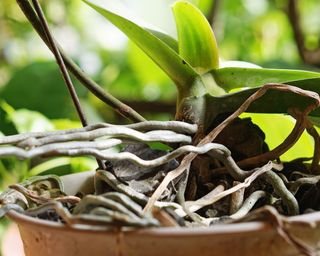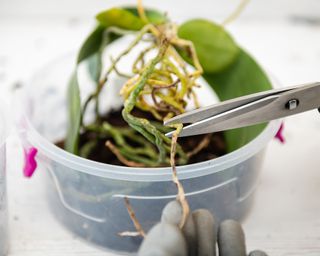Orchids are one of the largest families of flowering plants, with thousands of species found worldwide on every continent except Antarctica. They are notoriously difficult to grow, but caring for orchids effectively is easier than you might think.
Knowing when to repot orchids is key to caring for these exotic flowers. Over time, the soil will decompose and become compacted, depleting the available nutrients. Repotting your orchid will refresh the soil and give the plant the boost it needs to grow new.
If you want to revive a weak orchid or encourage it to produce more flowers, repotting can make a difference in improving the health of the plant.
Because there are so many different types of orchids, you will need to follow the care requirements for your particular species. For example, the best growing medium may include more absorbent material for species that don’t like to dry out, or it may be a drier bark mix for pseudobulbs that retain more water in the plant.
Choosing the right pot for your orchid is also important. Clear plastic pots with drainage holes are best as they allow you to check the health of the orchid’s roots.
When to repot orchids
Most orchids need to be repotted about every two years. However, rather than following a schedule, it is best to monitor the plant for signs that it is ready to be transplanted.
The best time to repot an orchid is when it is not actively growing. The cooler temperatures and lower light levels of fall and winter naturally slow down the growth of the plant.
Unless there is an urgent need to repot, such as in the case of disease or insects, wait until the flowers fade.

(Image source: Getty Images)
Signs It’s Time to Repot Your Orchid
- When aerial roots are growing vigorously or underground roots take over the entire pot. In these cases, the roots cannot get enough moisture and keeping the plant hydrated becomes difficult. If watering your orchid has become a daily chore, it is time to repot the plant.
- When the environment is damaged or moldy or otherwise damaged. After a few years, the bark and other materials will stink, rot and crumble easily in your fingers.
- When plants are affected by fungal diseases or orchid pests. Too wet and old material can create mold or other fungal organisms. Mealybugs and other insects often invade the growing environment.
- When your pot is not suitable. It may be too small or too large, or too porous or too airtight. Whether natural evaporation is needed or moisture needs to be retained for the plant, the pot needs to be suitable for those conditions. Unglazed clay pots will dry out faster, while glazed ceramic pots will retain water.
- When there are dead roots. This is a sign to remove the pot from the old medium and carefully prune to remove dead or diseased roots and refresh the medium.
- As the orchid potting mix decomposes, the soil particles become smaller, compacting the soil and reducing the amount of oxygen that can get into the soil. As the soil becomes finer, it holds more soil, which is not good for most orchid roots. Root rot and other fungal diseases often occur under these conditions.

(Image source: Getty Images)
Tips for repotting orchids
Before repotting your orchid, trim the old flower stem to the bottom node. Remove any stakes and clips. For newer flowers, cut 1 inch (2.5 cm) from the top node.
Remove the plant from the pot and shake off the old soil. Inspect the roots. Using sterile shears or pruning shears, cut away any roots that are diseased, soft, or discolored. Orchid roots should be evenly colored and firm.
Some orchid experts recommend sprinkling cinnamon on the roots after pruning to prevent fungal diseases.
Choose a pot that is 1-2 inches (2.5-5cm) larger than the previous one. Repot and fill in around the roots with new potting medium. Water and care for the plant as usual.
About orchid pots
The size of the pot depends on the size of the plant. For most orchids, choose a pot with a top diameter that is one-third the height of the orchid.
You can buy beautiful ceramic pots, almost like doily patterns, that have decorative gaps to increase airflow. You can also choose a plain, unglazed terracotta pot. This will work for most pots.
Orchids that need to be kept fairly moist will do well in plastic pots that retain moisture. Others will thrive in mesh pots lined with sphagnum moss and orchid growing medium. When in doubt, mimic the pot the plant was grown in, but increase the pot size when it is time to repot.

(Image source: Getty Images)
Suitable soil mix
Many orchids do not grow in soil. They will not grow well in gardens or potting soil. Many of these are epiphytes and grow in tree forks, rock crevices and other areas that are essentially bare of soil. They need a very well drained environment that allows air to pass through.
Most store-bought orchid potting mixes are made from bark, sphagnum moss, aspen, and lava rock. The most common barks in these mixes are fir and Monterey bark. Clay pellets may also be added to the mix to increase drainage and prevent compaction.
